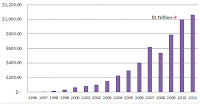The mutual fund industry has been taking it on the chin lately. Investors are becoming increasingly disillusioned with the product. Reasons vary, but most point to years of poor performance coupled with downside risks that are higher than even the downside
risks of hedge funds. In late 2008 the loss in many equity mutual funds was double that of an average hedge hedge fund. As an example the chart below compares the Fidelity Contrafund (one of the largest actively managed equity funds in the world) with the CS Hedge Fund Index in 2008. Many other equity mutual funds performed in a similar fashion.
 |
| Credit Suisse Hedge Fund Index versus Fidelity Contra Fund (Bloomberg) |
Another issue that generated dissatisfaction in mutual funds is the inherent conflict of interest in the industry.
NYT: The companies that manage for-profit mutual funds face a fundamental conflict between producing profits for their owners and generating superior returns for their investors. In general, these companies spend lavishly on marketing campaigns, gather copious amounts of assets — and invest poorly. For decades, investors suffered below-market returns even as mutual fund management company owners enjoyed market-beating results. Profits trumped the duty to serve investors.
And disappointed customers are voting with their wallets - and assets. The total number of mutual funds has been on the decline.
 |
| Total number of mutual funds (Source: Investment Company Institute) |
The market share lost by mutual funds is not surprisingly shifting to ETFs. ETF fees tend to be lower, yet they provide better liquidity and the ability to time the market, including intraday trading. That makes ETFs appealing not just to retail investors, but to institutions as well.
IndexUniverse: Exchange-traded funds pulled in twice as much new money as mutual funds did in 2011 in what amounts to the latest sign that the ETF juggernaut is gathering momentum, increasingly at the expense of mutual funds.
Traditional mutual funds gathered $58.58 billion in net new money in 2011, according to estimates by Morningstar, the Chicago-based financial data firm. That compares to inflows of more than $119 billion into ETFs last year, according to data compiled by IndexUniverse.
It’s a surprising outcome in that the mutual fund industry is about seven times as big as the ETF industry in terms of assets under management.
The chart below shows that the competition for market share, at least in the equity asset class, really started around 2006 as asset flows into mutual funds and ETFs diverged.
 |
| Source: Credit Suisse |
The worst loss of assets has been in the actively managed mutual funds. That is not surprising given they tend to charge higher fees and on average underperform equity indices.
IndexUniverse Without the inflows into passive funds, actively managed funds of all stripes shed about $6.7 billion in 2011.
This trend should continue as investors look to the most efficient products to express their views. And right now paying fees for an actively managed fund that is expected to underperform just doesn't look that efficient.
SoberLook.com
















